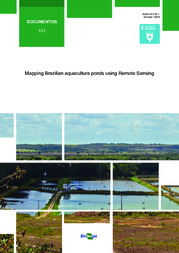Mapping Brazilian aquaculture ponds using Remote Sensing.
Mapping Brazilian aquaculture ponds using Remote Sensing.
Autoria: SÃO JOSÉ, F. F. DE; NOVO, Y. C. DE C.; FARIAS, A. R.; MAGALHÃES, L. A.; FONSECA, M. F.
Resumo: ABSTRACT: Aquaculture activities have been part of mankind's history for centuries. In Aktihep's tomb (2,500 B.C.), ancient Egypt, scenes of men removing tilapias from aquaculture ponds are depicted (Basurco; Lovatelli, 2003). In Brazil, aquaculture is defined by Brazilian federal law no. 11,959, from June 29, 2009, as the total or partial growth of organisms in aquatic environments, typically within a confined or controlled space. Fishing may be defined as the capture of fishery resources in a natural environment. Aquaculture's advantage over fishing is the generation of more homogeneous, traceable, and consistently available products (Embrapa Pesca e Aquicultura, 2022a). Fishing and aquaculture play an essential role in food production and supply for both human and animal consumption, and also generate employment and income in various parts of the world. Economic forms of production are practiced as standalone activities or in association with other agricultural activities, such as farming and livestock rearing (Allison, 2011). There are also hybrid production systems, such as rice?shrimp or rice?fish (Renaud et al., 2015). In this context, aquaculture has a multiplier economic potential in rural frontiers (Allison, 2011). The applicability of Remote Sensing products and services to aquaculture may be divided into three areas: i) monitoring water quality, ii) selecting areas for aquaculture activities, and iii) mapping and monitoring aquaculture production structures (Boivin et al., 2004). The latter is essential for the formulation of appropriate regulations and the provision of government incentives, for the territorial planning of aquaculture activities, and to provide statistical and geospatial data for market intelligence studies. Over the last decades, scientific researches on aquaculture have shed light on the role played by this economic activity as a replacement for fisheries, as well as on its environmental and social impacts and on the outcomes of this change for global food production (Naylor et al., 2000). There is a trend for greater technological developments in management, with the aim of reducing unwanted environmental effects, increasing product quality and improving the industry's potential for employment and income generation (FAO, 2020; 2021).
Ano de publicação: 2023
Tipo de publicação: Folhetos
Unidade: Embrapa Territorial
Palavras-chave: Agriculture, Geoprocessing, Sentinel
Observações
1 - Por padrão são exibidas publicações dos últimos 20 anos. Para encontrar publicações mais antigas, configure o filtro ano de publicação, colocando o ano a partir do qual você deseja encontrar publicações. O filtro está na coluna da esquerda na busca acima.
2 - Para ler algumas publicações da Embrapa (apenas as que estão em formato ePub), é necessário ter, no celular ou computador, um desses softwares gratuitos. Sistemas Android: Google Play Livros; IOS: iBooks; Windows e Linux: software Calibre.
Acesse outras publicações
Acesse a Base de Dados da Pesquisa Agropecuária (BDPA) para consultar o acervo completo das bibliotecas da Embrapa.

